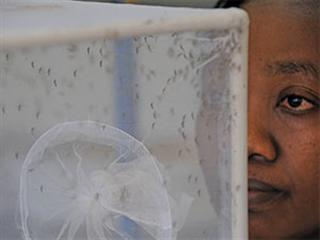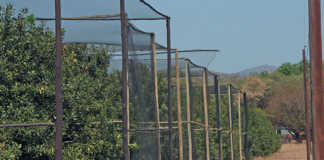
Small-scale dairy farmers in Kisii, in the Western Highlands of Kenya, have been moving to the ‘zero grazing’ model, feeding their dairy cows in well-ventilated shelters rather than allowing them to graze on open veld. A downfall of this system is that biting flies and other disease vectors are attracted to the sheds and waste pits, where they cause significant annoyance to the cattle. This reduces feed intake and hence milk production. The insects also frequently transmit diseases such as bluetongue.
Tsetse fly, which transmits sleeping sickness to humans and nagana to animals, are found in abundance in milking sheds. Although tsetse fly was eradicated from milk-producing areas in South Africa many years ago, it continues to be a massive problem in the rest of sub-Saharan Africa, being responsible for the death of three million cattle and economic losses amounting to more than $4,5 billion (R45 billion) annually, according to the Food and Agriculture Organisation (FAO) of the UN.
Burkhard Bauer, an independent scientific advisor at the Free University of Berlin, saw first-hand the numbers of animals killed by tsetse fly-borne disease while working with the FAO in Kenya in 2001. “We were treating animals that were already sick, but they kept dying. So we needed to look at the real culprits – the insects that transmit the disease,” he said.
He came up with a simple solution – a 75-denier net impregnated with pyrethroid insecticide to protect the livestock. Since tsetse flies fly close to the ground, the nets only have to be 1m high, and are erected at ground level around livestock sheds. The nets have reduced the number of flies, mosquitoes and other disease-transmitting vectors by nearly 90%, and cases of bacterial mastitis, a disease that can be spread by flies, as well as poor hygiene during milking, have been halved on smallholder dairy farms.
Participating farmers observed that the nets reduced animal disturbance caused by nuisance flies, decreased the numbers of attacking tsetse flies, ensured better feed intake, and improved milk production.
Milk up, malaria down
Milk production has been doubled and in some cases tripled on smallholder dairy farms, while the number of mosquitoes in nearby homes has also been reduced. In Kisii, farmers have reported 40% fewer cases of malaria. Smallscale farmer Mary Munyega Nyandeo said that her milk volumes had doubled. “I used to milk about 2l per cow per day. Since the nets were introduced and the flies have disappeared, I now milk around 4l or 5l a day, so I make a profit. What’s more, we’ve had no more malaria.”
By changing the amount of insecticide used and ensuring that the nets reach down to the ground, farmers can also reduce tick problems and lower the tick-borne diseases, such as East Coast Fever, which is widespread in Eastern Africa. This is according to Raffaele Mattioli, FAO senior officer in the Animal Health Service. The nets are being used as part of an FAO project among the rural poor to control animal disease through the development of innovative, site-specific animal health packages.
“These packages with nets to protect the cow shelters and the waste pits have proved effective against biting flies and mosquitoes, and have also improved animal health across the board,” said Rajinder Saini, an entomologist at the African Insect Science for Food and Health, FAO’s implementing partner in Kisii. “The cows are calmer. They don’t waste energy stomping their feet and flicking their tails, and they are converting feed better, gaining weight and producing more milk. The farmers are obviously happy too,” Saini said.
Source: United Nations Food and Agriculture Organisation.













